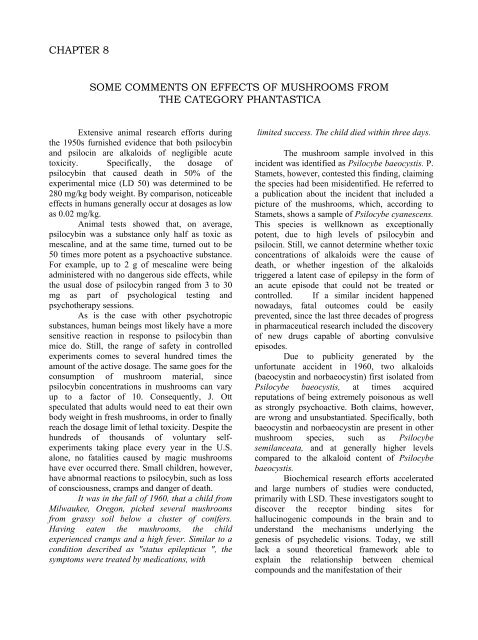Jochen Gartz - Magic Mushrooms Around the ... - preterhuman.net
Jochen Gartz - Magic Mushrooms Around the ... - preterhuman.net
Jochen Gartz - Magic Mushrooms Around the ... - preterhuman.net
Create successful ePaper yourself
Turn your PDF publications into a flip-book with our unique Google optimized e-Paper software.
CHAPTER 8<br />
SOME COMMENTS ON EFFECTS OF MUSHROOMS FROM<br />
THE CATEGORY PHANTASTICA<br />
Extensive animal research efforts during<br />
<strong>the</strong> 1950s furnished evidence that both psilocybin<br />
and psilocin are alkaloids of negligible acute<br />
toxicity. Specifically, <strong>the</strong> dosage of<br />
psilocybin that caused death in 50% of <strong>the</strong><br />
experimental mice (LD 50) was determined to be<br />
280 mg/kg body weight. By comparison, noticeable<br />
effects in humans generally occur at dosages as low<br />
as 0.02 mg/kg.<br />
Animal tests showed that, on average,<br />
psilocybin was a substance only half as toxic as<br />
mescaline, and at <strong>the</strong> same time, turned out to be<br />
50 times more potent as a psychoactive substance.<br />
For example, up to 2 g of mescaline were being<br />
administered with no dangerous side effects, while<br />
<strong>the</strong> usual dose of psilocybin ranged from 3 to 30<br />
mg as part of psychological testing and<br />
psycho<strong>the</strong>rapy sessions.<br />
As is <strong>the</strong> case with o<strong>the</strong>r psychotropic<br />
substances, human beings most likely have a more<br />
sensitive reaction in response to psilocybin than<br />
mice do. Still, <strong>the</strong> range of safety in controlled<br />
experiments comes to several hundred times <strong>the</strong><br />
amount of <strong>the</strong> active dosage. The same goes for <strong>the</strong><br />
consumption of mushroom material, since<br />
psilocybin concentrations in mushrooms can vary<br />
up to a factor of 10. Consequently, J. Ott<br />
speculated that adults would need to eat <strong>the</strong>ir own<br />
body weight in fresh mushrooms, in order to finally<br />
reach <strong>the</strong> dosage limit of lethal toxicity. Despite <strong>the</strong><br />
hundreds of thousands of voluntary selfexperiments<br />
taking place every year in <strong>the</strong> U.S.<br />
alone, no fatalities caused by magic mushrooms<br />
have ever occurred <strong>the</strong>re. Small children, however,<br />
have abnormal reactions to psilocybin, such as loss<br />
of consciousness, cramps and danger of death.<br />
It was in <strong>the</strong> fall of 1960, that a child from<br />
Milwaukee, Oregon, picked several mushrooms<br />
from grassy soil below a cluster of conifers.<br />
Having eaten <strong>the</strong> mushrooms, <strong>the</strong> child<br />
experienced cramps and a high fever. Similar to a<br />
condition described as "status epilepticus ", <strong>the</strong><br />
symptoms were treated by medications, with<br />
limited success. The child died within three days.<br />
The mushroom sample involved in this<br />
incident was identified as Psilocybe baeocystis. P.<br />
Stamets, however, contested this finding, claiming<br />
<strong>the</strong> species had been misidentified. He referred to<br />
a publication about <strong>the</strong> incident that included a<br />
picture of <strong>the</strong> mushrooms, which, according to<br />
Stamets, shows a sample of Psilocybe cyanescens.<br />
This species is wellknown as exceptionally<br />
potent, due to high levels of psilocybin and<br />
psilocin. Still, we cannot determine whe<strong>the</strong>r toxic<br />
concentrations of alkaloids were <strong>the</strong> cause of<br />
death, or whe<strong>the</strong>r ingestion of <strong>the</strong> alkaloids<br />
triggered a latent case of epilepsy in <strong>the</strong> form of<br />
an acute episode that could not be treated or<br />
controlled. If a similar incident happened<br />
nowadays, fatal outcomes could be easily<br />
prevented, since <strong>the</strong> last three decades of progress<br />
in pharmaceutical research included <strong>the</strong> discovery<br />
of new drugs capable of aborting convulsive<br />
episodes.<br />
Due to publicity generated by <strong>the</strong><br />
unfortunate accident in 1960, two alkaloids<br />
(baeocystin and norbaeocystin) first isolated from<br />
Psilocybe baeocystis, at times acquired<br />
reputations of being extremely poisonous as well<br />
as strongly psychoactive. Both claims, however,<br />
are wrong and unsubstantiated. Specifically, both<br />
baeocystin and norbaeocystin are present in o<strong>the</strong>r<br />
mushroom species, such as Psilocybe<br />
semilanceata, and at generally higher levels<br />
compared to <strong>the</strong> alkaloid content of Psilocybe<br />
baeocystis.<br />
Biochemical research efforts accelerated<br />
and large numbers of studies were conducted,<br />
primarily with LSD. These investigators sought to<br />
discover <strong>the</strong> receptor binding sites for<br />
hallucinogenic compounds in <strong>the</strong> brain and to<br />
understand <strong>the</strong> mechanisms underlying <strong>the</strong><br />
genesis of psychedelic visions. Today, we still<br />
lack a sound <strong>the</strong>oretical framework able to<br />
explain <strong>the</strong> relationship between chemical<br />
compounds and <strong>the</strong> manifestation of <strong>the</strong>ir








![The Big Lie 9-11 and Government Complicity in Mass Murder [PDF]](https://img.yumpu.com/50957077/1/190x245/the-big-lie-9-11-and-government-complicity-in-mass-murder-pdf.jpg?quality=85)








